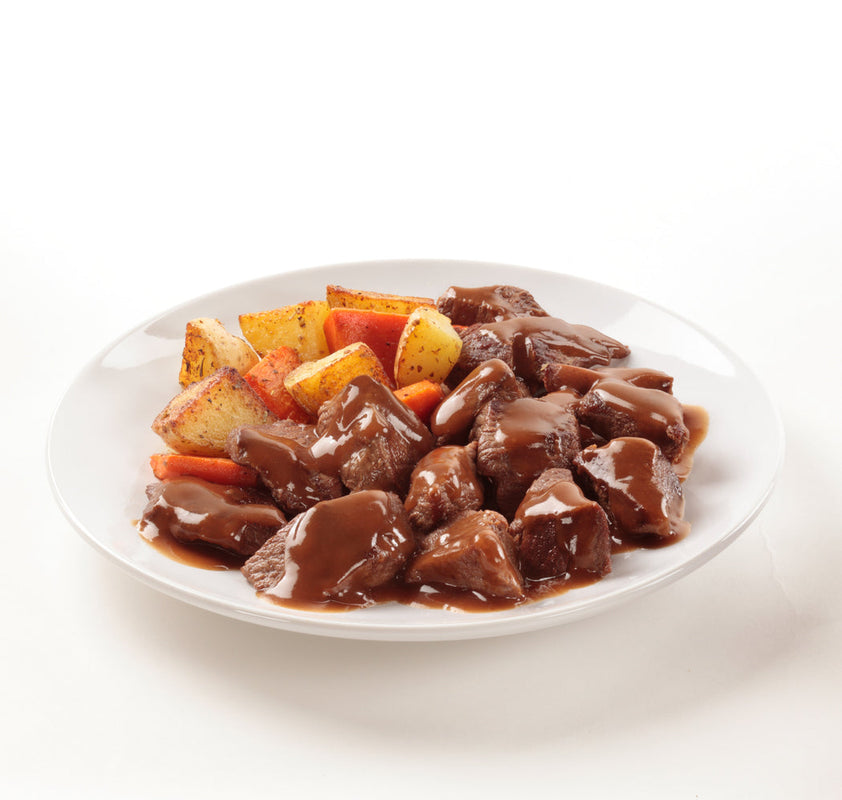Gravy is a much-loved addition to a variety of dishes, lending richness and depth of flavour to otherwise ordinary meals. Both British and American cooks have their own distinct interpretations of this culinary essential, often employing different techniques, ingredients, and textures. The popularity of gravy granules, especially in the United Kingdom, has opened up a world of convenience that resonates with busy households. In this article, we’ll explore the key differences between British gravy granules and American gravy granules, discuss some well-known British brands and take a look at how these products shape mealtime traditions on both sides of the pond.
The origins of gravy granules
Britain’s introduction of instant gravy powders and granules can be traced back to the early 20th century, although it was after the Second World War that they truly gained traction. The concept was simple yet revolutionary that is to create a product that, when mixed with hot water, forms a seamless gravy without the fuss of making a roux or skimming pan drippings.
In the United States, packaged gravy mixes also emerged as a convenient alternative to homemade gravies. However, American households maintained a strong attachment to freshly made pan gravy, often whisked from turkey drippings at Thanksgiving or built from scratch during family gatherings. This might explain why gravy granules are less ubiquitous in American supermarkets than in British ones, although demand for quick-and-easy options has continued to grow.
Key differences in ingredients and flavours

British gravy granules like Bisto Beef Gravy Granules Drum often start with a base of beef, chicken, or vegetable extracts, along with thickening agents such as starch. These granules usually yield a dark brown sauce, typically savoury and rich without being overly heavy. For individuals who are sensitive to gluten, Bisto Original Gravy Granules Gluten Free offers a coeliac-friendly alternative that still retains the full-bodied taste of traditional Bisto gravy.
On the other hand, American gravies can vary dramatically, ranging from the light and milky texture of Southern-style gravy, sometimes referred to as “country gravy” or “white gravy”, to the bold, full-bodied “brown gravy” served with roast beef or mashed potatoes.
Texture and consistency
British gravies, particularly those made from granules, are typically smooth, slightly thickened, and easily poured over meats or vegetables. The consistency is designed to lightly coat the food without overwhelming it. It also helps to bind elements of traditional British meals, such as roast beef, Yorkshire puddings, and roast potatoes.
By contrast, American gravies can fluctuate greatly in thickness. Southern white gravy is often deliberately thick and can even border on chunky, especially if it contains sausage or bacon bits. Pan gravy served during holidays might be thinner or thicker depending on the recipe and personal preference, but it often emphasises the meaty drippings. Despite the rise of pre-packaged mixes, many Americans still pride themselves on preparing gravy from scratch, seeing it as a hallmark of authentic cooking.
Final thoughts
Although both British and American gravy granules share the same purpose, enhancing the flavour and texture of dishes, they reflect different cultural traditions and consumer preferences. British gravy granules lean towards convenience, variety, and a deep, savoury profile that complements the beloved Sunday roast.
In the United States, while instant mixes are available, the diverse landscape of gravy styles, ranging from creamy white gravies to savoury brown gravies, keeps home cooks firmly invested in traditional methods, especially during holidays and special occasions. Ultimately, both British and American gravy granules serve as a testament to the timeless appeal of good, hearty gravy, each style adding a unique touch of comfort to the global dining table.


 Christmas 2025
Christmas 2025
 Frozen Food
Frozen Food
 Baking
Baking
 Beans, Peas, Soups & Tins
Beans, Peas, Soups & Tins
 Biscuits, Crackers & Cookies
Biscuits, Crackers & Cookies
 Candy / Sweets
Candy / Sweets
 Crisps & Snacks
Crisps & Snacks
 Chemist / Pharmacy
Chemist / Pharmacy
 Desserts
Desserts
 Gravy, Stock & Paste
Gravy, Stock & Paste
 Haggis
Haggis
 Indian Sauces, Paste and Pickle
Indian Sauces, Paste and Pickle
 Jams & Preserves
Jams & Preserves
 Poppy Appeal
Poppy Appeal
 Pot Noodles & Super Noodles
Pot Noodles & Super Noodles
 Scone Mix
Scone Mix
 Gluten-Free / Free From
Gluten-Free / Free From
 Tea Accessories
Tea Accessories
 Teapot & Tea sets
Teapot & Tea sets
 Tea For One
Tea For One
 Sugar & Creamer
Sugar & Creamer
 Tableware
Tableware
 Serveware
Serveware
 Plates & Trays
Plates & Trays
 Bowls
Bowls
 Cups & Saucers
Cups & Saucers
 Mugs
Mugs
 Silverware
Silverware
 Dinnerware - Accessories
Dinnerware - Accessories
 Dinnerware - For Pets
Dinnerware - For Pets
 Victoria Eggs - Hand-Drawn UK Homeware
Victoria Eggs - Hand-Drawn UK Homeware
 Jewelry & Accessories
Jewelry & Accessories
 Sale
Sale
 Christmas Gifts
Christmas Gifts

